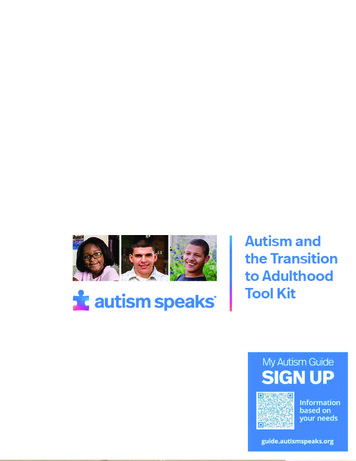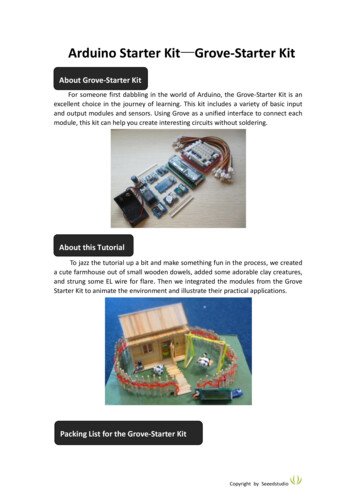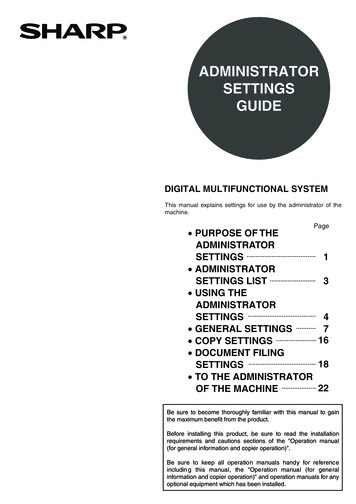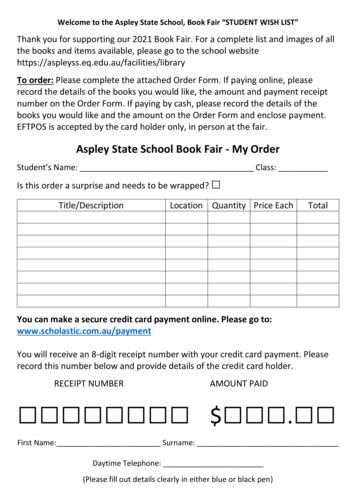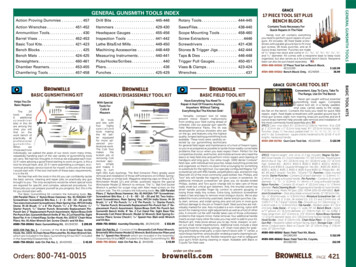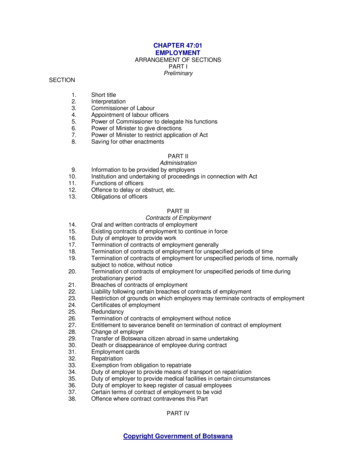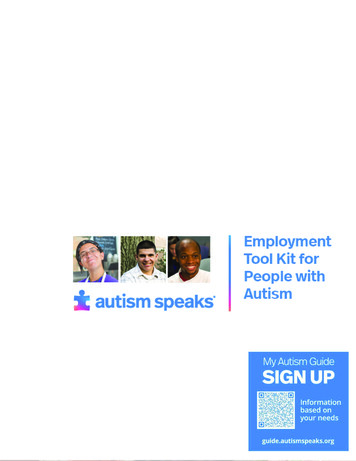
Transcription
Employment Tool Kit
Autism Speaks does not provide medical or legal advice or services. Rather, Autism Speaks providesgeneral information about autism as a service to the community. The information provided in this toolkitis not a recommendation, referral or endorsement of any resource, therapeutic method, or service providerand does not replace the advice of medical, legal or educational professionals. Autism Speaks has notvalidated and is not responsible for any information or services provided by third parties. You are urged touse independent judgment and request references when considering any resource associated with theprovision of services related to autism. 2013 Autism Speaks Inc. Autism Speaks and Autism Speaks It’s Time To Listen & Design are trademarks owned by Autism Speaks Inc. All rights reserved.
AcknowledgementsWith gratitude, we thank the members of our Advisory Committees for generously donating their time,experience and resources to this project. Cesilee Coulson, Executive Director at The Washington Initiative for Supported Employment (WISE) James Emmett, Corporate Disability Consultant at Social Coaching Institute Amy Gravino, Self-Advocate and College Coach, Consultant & Speaker at A.S.C.O.T Coaching, LLC Tracey Gray-Walker, Parent, Senior Vice President and Chief Diversity Officer at AXA Equitable Ilene Lainer, Parent and Executive Director at New York Collaborates for Autism (NYCA) Mark Lazaar, Autism Specialist at Aspiritech Lu Merrick, Director, Post High School Programs, The Ivymount School Gary W. Moore, Parent and Founder & President at nonPareil Institute Kathryn Nordberg, Parent, Founder and CEO, Erik’s Ranch & Retreats Kevin J. O'Mara, Ph.D., CMA, Parent, President of the Academy of Business Education, andProfessor of Management at The Martha and Spencer Love School of Business, Elon University Rachel Pollack, Chief Operating Officer and General Counsel at Job Path, Inc. Katrina Reese, Assistant Director of Employment Services at Job Path, Inc. Michelle Rubin, Parent, Founder & Director of Autism After 21 Marcia Scheiner, Parent, President & Founder, Asperger Syndrome Training &Employment Partnership (ASTEP) Laura Shumaker, Parent, Author (A Regular Guy: Growing Up With Autism),Blogger for The San Francisco Chronicle Jeremy Sicile-Kira, Self-Advocate, Author (A Full Life with Autism), Student, andIntern & Youth Leader at Autistic Global Initiative (AGI) Dorothy Strickland, Creator of JobTIPS and President of Do2Learn.com John Taylor, Self-Advocate and Database Coordinator at Autism Speaks Andy Traub, Owner of Traub & Associates Consulting LLC Paul Wehman, PhD, Professor of Physical Medicine and Rehabilitation, Chairman of Division of RehabilitationResearch, and Director of VCU-RRTC at Medical College of Virginia, Virginia Commonwealth University Brenda Weitzberg, Parent, Executive Director at Aspiritech Moshe Weitzberg, PhD, Parent, Director of Operations at Aspiritech Susan M Wilczynski, PhD, BCBA-D, Plassman Family Distinguished Professor of Special Education andApplied Behavior Analysis, and President of Evidence-Based Practice SIG of ABAI Teachers CollegeAutism Speaks thanks the following supporterwhose generous contribution funded theEmployment Tool Kit: 2013 Autism Speaks Inc. Autism Speaks and Autism Speaks It’s Time To Listen & Design are trademarks owned by Autism Speaks Inc. All rights reserved.
Table of Contents Introduction.Page 11. Autism Speaks Employment Think Tank .Page 12. How Do I Use This Tool Kit to Find a Job? .Page 23. Matthew’s Employment Story .Page 24. Activity: What are some of the positive reasons for a job search?.Page 3 Self-Advocacy .Page 41. What are Self-Advocacy Skills? .Page 42. Justin’s Self-Advocacy Story.Pages 5-7 What Job is Right For You? .Page 81. Assessing your Strengths and Interests.Page 92. Activity: What types of assessments have I taken?.Page 93. Volunteering .Page 104. Internships and Apprenticeships .Page 105. Training to Work: Aspiritech.Page 116. Some Jobs to Consider .Page 117. Understanding the Labor Market .Page 138. Activity: Identify 3 types of jobs that match your skills and your interests.Page 13 Benefits and Funding.Page 141. Social Security .Page 142. Social Security Work Incentives (PASS, IRWE, Ticket to Work) .Pages 15-163. Funding Sources .Page 17 State Vocational Rehabilitation (VR) Services .Page 17 Developmental Disability Agencies/Home and Community Based Medicaid Waivers .Page 17 Centers for Medicaid & Medicare Services (CMS) .Page 174. Activity: Benefits and Funding Contacts Chart.Page 18 Employment Models – What Option Is Best for You? .Page 191. Competitive Employment .Page 192. Supported Employment .Page 193. Customized Employment.Page 194. Self-Employment .Page 205. Entrepreneur Success Story: Nathan Young and Autism Candles .Page 206. Activity: My Business Ideas.Page 217. Finding Supports Services and Providers in your Area .Page 228. Activity: Employment Services Planning Tool .Page 23 2013 Autism Speaks Inc. Autism Speaks and Autism Speaks It’s Time To Listen & Design are trademarks owned by Autism Speaks Inc. All rights reserved.
Your Job Search.Page 241. Networking.Page 242. Personal Perspective: “You Never Know Until You Ask” (Ilene Lainer).Page 253. Activity: My Networking Contacts.Page 254. Online Social Networking Sites .Page 265. Researching Companies and Jobs.Page 276. Activity: Job Search Planning Tool .Page 28 Transportation Options.Page 291. Activity: My Transportation Options .Page 29 Resumes, Cover Letters and Applications.Page 301. Resume Example .Page 302. Personal Perspective: “Building a Resume – One Accomplishment at a Time” (Michelle Rubin).Page 313. Resume Template .Page 324. Cover Letter .Page 335. Sample Cover Letter .Page 346. How to Send your Resume and Cover Letter .Page 357. Applications.Pages 35-37 The Job Interview .Page 381. Before the Interview .Page 382. Day of the Interview.Page 393. After the Interview .Page 40 Accommodations and Disclosure .Page 411. Universal Design for Accommodations .Page 412. Job Accommodation Network ( JAN).Page 413. Natural Supports .Page 414. Technology .Page 415. Useful Accommodations You Can Ask For .Page 426. Activity: Accommodations I Need to Be Employed .Page 437. To Disclose or Not to Disclose? .Page 448. Activity: Should I disclose that I have autism (at work)?.Page 44 Soft Skills – Understanding the Social Elements of your Job.Page 451. Definition of Soft Skills .Page 452. Resources.Page 45 Success Stories and Lessons Learned .Pages 46-49 My Employment Rights .Page 501. Enforcing the Laws .Page 512. Resources If You Feel Your Rights Have Been Violated .Page 51 Glossary Terms .Pages 52-54 Employment Resources .Pages 55-58 Step-by-Step Guide to Your Employment Search .Page 59 2013 Autism Speaks Inc. Autism Speaks and Autism Speaks It’s Time To Listen & Design are trademarks owned by Autism Speaks Inc. All rights reserved.
IntroductionThe Autism Speaks Employment Tool KitAutism Speaks would like to help you with your employment search by giving you tools and tips whileyou look for a job. As an adult on the autism spectrum, you have strengths and abilities that employers are justbeginning to understand. Therefore, we have written this guide to help you research, find and keep employmentin the current, competitive labor market.The Autism Speaks Employment Tool Kit is the culmination of a processthat began with the Autism Speaks Employment Think Tank in June 2012,which captured the current state of employment for adults with autism.From that Think Tank we collected advice, stories, best practice data, tipsand resources that we are happy to share with you. Click here to read theEmployment Think Tank Executive Summary.In addition to using the information gathered through the Autism SpeaksEmployment Think Tank, it is important to state that this EmploymentTool Kit was developed by a diverse group of stakeholders led by adults withan autism spectrum disorder, parents, business leaders, and academic experts.Stories, tips and resources were developed from this collaboration of peoplededicated to increasing the employment participation of adults on the spectrum.Although this Employment Tool Kit is geared towards you, we know that families, transition coordinators,vocational rehabilitation staff, business leaders and anyone who is helping someone with autism find and keepemployment will also find this resource helpful. The blue text indicates a link that you can click on for additional information.The notebook icon indicates helpful hints that you may want toremember and write down in the space provided.PAGE 1 2013 Autism Speaks Inc. Autism Speaks and Autism Speaks It’s Time To Listen & Design are trademarks owned by Autism Speaks Inc. All rights reserved.
How Do I Use This Tool Kit to Find a Job?You are probably reading this Tool Kit because you are interested in learning about finding a job. This guideis divided into specific sections so you can choose to go through each section in order, or you can skip to an areathat applies to your needs. To be an active part of your own employment search, we start the Tool Kit with someuseful tips about self-advocacy, ways to plan your employment search and supports, tips on how to determine theright job for you, funding options, provider agencies that can help and other useful tools and tips. Whether youare looking for part-time or full-time employment, want to find a job on your own or are looking for supports, youwill find what you need in this Tool Kit. We want to give you all the options that are available. Not all the recommendationswill apply to you, so review the course of action that you need. This Employment Tool Kit we help you gatherinformation on finding, getting and keeping a job with specific action steps to help you organize your job search.Looking for a job can be a long process. It is important to focus on the positive steps to gaining employmentsuch as networking and meeting new people, learning about your strengths, learning new skills and exploringcareers. Choose a team to help you with your job search that includes the people that know you best and a knownsupported employment agency in your area if you need that support. Click here to visit the Employment Resourcesection of the Autism Speaks Resource Guide. From there, enter your zip code to view a list of employment serviceproviders in your area.We start with a success story. If you have one of your own, we would love to hear from you! Please sendit to us at AdultServices@autismspeaks.org.Matthew’s Employment Story: Matthew ShumakerMatthew Shumaker, a 26-year-old with autism from Northern California,has been interested in garden and landscape work since he was a child. By thetime he was 16, Matthew was mowing, trimming and blowing the yards of manyof his neighbors. His skills and interests were narrow, however, and he was notgood at taking direction. He had a hard time, for example, understanding thatsome bushes and hedges look better if they aren’t cut back too severely, or in toomuch of a straight line. He did not like to do some of the necessary grunt workassociated with gardening, such as digging and cleanup.Matthew moved to a supported living programin Camphill Communities in California whenhe was 22 years old, where he took part in avocational training program that included intense garden and landscape training.Matthew at 22 in vocational trainingIt was still difficult to persuade Matthew todo some of the less pleasant garden tasks, and tolearn the importance of taking direction fromthe customer. But over time, he mastered theseskills. He expressed his desire to obtain outsidepaid work. His supported living plan wasmodified to include a supported employmentprogram. Matthew now works with a job coachthree mornings a week. He works independentlyat least two days a week and occasionally onweekends. His goal is to continue building skills,and to eventually work full-time.Matthew, 11, with his first lawnmowerMatthew, 26, with his first paycheck!PAGE 2 2013 Autism Speaks Inc. Autism Speaks and Autism Speaks It’s Time To Listen & Design are trademarks owned by Autism Speaks Inc. All rights reserved.
Matthew represents just one individual with a particular vocational interest and ability. His job brings himmuch satisfaction and enjoyment. Your story will be different. So starting your employment search will requireyou to take action steps to secure the type of job that matches your vocational interests and abilities. Start yourindividual journey to employment with positive reasons for your job search.What are some of the positive reasons for a job search?Use this page to write down positive reasons for a job searchI could earn money so thatI have more controlover my own life.I will meet peoplein my field of interest.PAGE 3 2013 Autism Speaks Inc. Autism Speaks and Autism Speaks It’s Time To Listen & Design are trademarks owned by Autism Speaks Inc. All rights reserved.
Self-AdvocacyOne of the most critical features of being an adult is the ability to make your own choices in life. Where youwork and what job you perform are important choices and require decision making skills that you will use oftenas an adult. Use this section to develop strategies that can help you advocate for yourself as you start your journeyinto employment and adult life.What are Self -Advocacy Skills?Valerie Paradiz, Ph.D. offers a good description of self-advocacy and why it is so important.“Self-advocacy is a life-long endeavor [and it is never too early – or late] to start cultivating self-awareness,self-monitoring, and deeper exploration of what it means to be autistic, by way of peer discussion groups.Self-advocacy differs from advocacy in that the individual with the disability self-assesses a situation or problem,and then speaks for his or her own needs. Learning how to do this takes practice and direct instruction. Toooften, we raise our kids, treat our patients, and educate our students without ever speaking to them directlyabout autism. Perhaps we’ve made assumptions or even harbor fears that they aren’t capable of self-reflection.Yet if we deny kids our children this very important aspect of identity,we limit their ability to become the successful adults we want them tobe. As with any academic subject, teaching self-advocacy takes trainingas well as knowledge of and respect for the disability movement. Parentscan model self-advocacy at home, teachers can offer curricula in school,and most importantly, peers on the autism spectrum can offer strategiesfor good living and share mutual experiences.”To read Dr. Paradiz’s full article, visit this website: DevelopingSelf Advocacy Skills: An Integral Aspect of Transition Planning.Self-Advocacy is: speaking up for yourself asking for what you need negotiating for yourself (working with others to reach an agreement that will meet your needs) knowing your rights and responsibilities using the resources that are available to you being able to explain your disability either by the use of written words, pictures or gesturesLearning to ask for help is another step in developing self-advocacy skills. In order to do this, you must be ableto identify that there is an obstacle or difficulty, and then seek out assistance to have the issue resolved.PAGE 4 2013 Autism Speaks Inc. Autism Speaks and Autism Speaks It’s Time To Listen & Design are trademarks owned by Autism Speaks Inc. All rights reserved.
Justin’s Self-advocacy Story: Justin HaynesJustin, an employee at the National Institute for Health in Bethesda, Md., decided to share his socialchallenges with his co-workers by creating a PowerPoint presentation explaining how he has been impacted byautism. He shared his presentation at a department meeting with his co-workers and supervisors at the NIH.You can learn more about Justin by viewing some of the slides from that presentation below. His story is alsofeatured in the book: High School Transition that Works! Lessons Learned from Project, by Maryellen Datson,J. Erin Riehle and Susie Rutkowski (page 196).A note about disclosure: By sharing his story, Justin was advocating for himself and working to improve his workperformance and relationship with his co-workers. Not everyone will want to disclose their autism to their employeror co-workers in as public a way as Justin did. It is your choice. Skip ahead to the Soft Skills – Understanding theSocial Elements of Your Job Section for more thoughts on disclosure and how it can affect your job.PAGE 5 2013 Autism Speaks Inc. Autism Speaks and Autism Speaks It’s Time To Listen & Design are trademarks owned by Autism Speaks Inc. All rights reserved.
PAGE 6 2013 Autism Speaks Inc. Autism Speaks and Autism Speaks It’s Time To Listen & Design are trademarks owned by Autism Speaks Inc. All rights reserved.
PAGE 7 2013 Autism Speaks Inc. Autism Speaks and Autism Speaks It’s Time To Listen & Design are trademarks owned by Autism Speaks Inc. All rights reserved.
What Job is Right for You?It is important to understand your strengths and interests when you are looking for a job. We all hope tofind a job that we are very good at and that we can truly enjoy doing for a long time – our dream job! But beingrealistic is important, too. Sometimes we need to realize that what we are good at is not always something wecan do as paid employment, or there may not be a job available that matches our top interests. That’s ok! A goodapproach is to list your personal strengths and interests, and then search the job market to see what positions areavailable that match up most closely with those ideals.YOUR STRENGTHS:What you are good at.YOUR INTERESTS:What you like to do.DREAMJOBJOB MARKET:Jobs that are available in the job market.PAGE 8 2013 Autism Speaks Inc. Autism Speaks and Autism Speaks It’s Time To Listen & Design are trademarks owned by Autism Speaks Inc. All rights reserved.
Assessing Your Strengths and InterestsHaving a formal assessment of your skills and interests will help you choose the direction of your job search.There are many useful tools that can help determine these factors for you. Some of these tools can includefunctional and community-based vocational assessments and interest inventories. Vocational assessments canbe administered by your state’s Vocational Rehabilitation (VR) office by a vocational rehabilitation counselor.Each state has a VR agency that provides employment service supports to people with disabilities (includingautism). Click here to find contact information for your state’s VR office. In addition to assessments, your state’sVocational Rehabilitation office offers a variety of other services and funding. Click here for additional informationabout funding options.For more information on assessments, visit these websites: Do2Learn.com Institute for Community Inclusion (ICI) Occupational Information Network (O*Net)Document the types of assessments that you have participatedin. If you have not had an assessment, request one from yourvocational counselor.AssessmentsIn SchoolJob-Related A community-based Vocational assesment through my DVRS Counselor PAGE 9 2013 Autism Speaks Inc. Autism Speaks and Autism Speaks It’s Time To Listen & Design are trademarks owned by Autism Speaks Inc. All rights reserved.
VolunteeringIn addition to formal assessments, volunteering is a great way to learn about your interests and abilitiesprior to paid employment. There are many organizations that offer volunteer opportunities where you arenot paid. Do not pass up a chance for work experience, as you will learn from all types of opportunities. Evenlearning that you do not enjoy a particular type of work is information that will lead you to the right career pathin the future.For more information on volunteering and to find volunteer opportunities in your area, visit these websites: Volunteers of America Volunteer MatchNote: Many states have their own volunteer agencies – try Googling it!TIP: Always make sure that you get a recommendation letter from your supervisor when you have had agood work/volunteer experience. Update your resume with each work opportunity you have had so that it isalways current. Don’t forget about work experience that you may have gotten while you were in school or duringthe summer. All work experience is important and could help you get that next job.Internships and ApprenticeshipsA paid or unpaid internship is another way for you to learnvocational skills and gain valuable work experience. Your schoolshould be able to assist you in finding internship opportunities.Some internships can offer you college credit for your work.An apprenticeship is a combination of on-the-job trainingin which workers learn the practical and theoretical aspects ofa highly skilled occupation or trade from experts in the field.Apprenticeships can teach you skills for a trade that is in highdemand in the job market. This may make it easier for you tofind a job. For more information on apprenticeships, visit theU.S. Department of Labor.PAGE 10 2013 Autism Speaks Inc. Autism Speaks and Autism Speaks It’s Time To Listen & Design are trademarks owned by Autism Speaks Inc. All rights reserved.
Training to Work: AspiritechOccupational and Vocational Training for Software TestersOccupational and vocational training can take a number offorms, from pre-employment activities to on-the-job coaching.At Aspiritech, a not-for-profit near Chicago, Ill., we providetraining and employment for adults with high-functioningautism and Asperger Syndrome. Our training covers both thetechnical skills of software testing, and the soft skills neededto succeed in the workplace. The initial training period, whichis provided at no cost, covers the basics of software testing andis designed to be accessible to individuals on the spectrum whopossess a moderate level of computer proficiency (programmingskills are not required). It is hands-on and avoids abstractlessons to meet the needs of trainees with challenges in auditoryprocessing and a more literal sense of language. This training period can last anywhere from a couple weeksto a couple months, depending on the needs, pace, and availability of the trainee. In addition to learningsoftware testing, the initial training serves as an evaluation period and opportunity for trainees to learn ifsoftware testi
vocational training program that included in-tense garden and landscape training. It was still difficult to persuade Matthew to do some of the less pleasant garden tasks, and to learn the importance of taking direction from the customer. But over time, he mastered these skills



